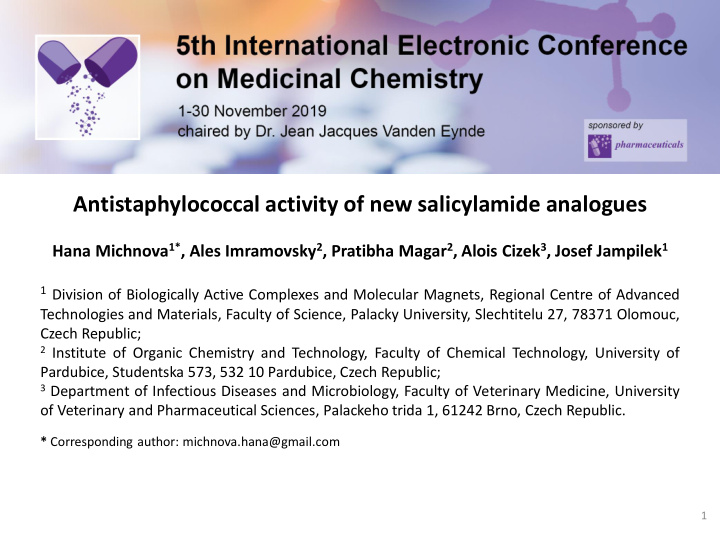



Antistaphylococcal activity of new salicylamide analogues Hana Michnova 1* , Ales Imramovsky 2 , Pratibha Magar 2 , Alois Cizek 3 , Josef Jampilek 1 1 Division of Biologically Active Complexes and Molecular Magnets, Regional Centre of Advanced Technologies and Materials, Faculty of Science, Palacky University, Slechtitelu 27, 78371 Olomouc, Czech Republic; 2 Institute of Organic Chemistry and Technology, Faculty of Chemical Technology, University of Pardubice, Studentska 573, 532 10 Pardubice, Czech Republic; 3 Department of Infectious Diseases and Microbiology, Faculty of Veterinary Medicine, University of Veterinary and Pharmaceutical Sciences, Palackeho trida 1, 61242 Brno, Czech Republic. * Corresponding author: michnova.hana@gmail.com 1
Antistaphylococcal activity of new salicylamide analogues Graphical Abstract 2
Abstract: Antimicrobial resistance is still a serious global threat. Staphylococcus aureus is a common cause of severe infections in health facilities and the community. People with methicillin- resistant S. aureus (MRSA) are estimated to be 64% more likely to die than people with a non- resistant form of the infection. For that reason, the research and development of new active compounds is really needed. Salicylamides are anti-infectious agents with a wide range of pharmacological effects, such us antiviral, antibacterial, antifungal and anthelminthic. Thus, derivatives of this group are very promising compounds. A series of newly synthesized complex salicylamide derivatives was tested for their antimicrobial effect against methicillin-resistant Staphylococcus aureus (MRSA). Staphylococcus aureus ATCC 29213 as a control and three isolates of MRSA were used. The activity was assessed by the evaluation of minimum inhibitory concentration. Using the microdilution method with subcultivation of aliquots, the minimum bactericidal concentration was determined too. Ciprofloxacin and ampicillin were used as standard antibacterial drugs. Four most promising compounds from the series were chosen and are demonstrated in this contribution. Keywords: antibacterial activity; Staphylococcus aureus; MRSA; salicylamide 3
Introduction Testing of antistaphylococcal activity of newly synthesized compound is very important and needed because of severity of resistance and global dissemination of methicillin- resistant S. aureus (MRSA) strains. Salicylamide derivatives are really promised compounds thanks to their wide spectrum of activity. Previous series of these structures was tested for its effect against VRE (vancomycin-resistant enterococci). Three of the investigated compounds showed strong bacteriostatic activity against VRE (0.199 – 25 µM) comparable to or more potent than ampicillin and ciprofloxacin 1 . New salicylamide-based compound were prepared and tested against three isolates of MRSA – MRSA 63718, MRSA SA 630 and MRSA SA 3202. Minimum inhibitory concentration (MIC) was assessed by microdilution method with microtitration plate. Each compound was diluted to concentration 256 – 0.008 µg/ml . The MIC was defined as the lowest concentration of the compound, at which no visible bacterial growth was observed. Minimum bactericidal concentration (MBC) was determined by subcultivation of aliquots from previous testing. Results are expressed in "µM" unit for higher informative value. 1. Pospíšilová , Š .; Michnová , H.; Kauerová , T.; Pauk, K.; Kollár , P.; Vinšová , J.; Imramovský , K.; Čížek , A.; Jampílek , J. In vitro activity of salicylamide derivatives against vancomycin-resistant enterococci. Bioorg. Med. Chem. Lett. 2018 , 28 , 2184-2188.
Results Table 1: Minimum inhibitory (MIC) and bactericidal (MBC) concentration [µM]; S. aureus – Staphylococcal aureus , cpx – ciprofloxacin, amp - ampicillin S. aureus ATCC MRSA 63718 MRSA SA 3202 MRSA SA 630 29213 Compound MIC MBC MIC MBC MIC MBC MIC MBC 1 1.17 1.17 0.07 0.07 1.17 1.17 1.17 1.17 2 1.08 2.16 0.27 0.27 2.16 2.16 1.08 17.28 3 222 > 444 > 444 > 444 444 > 444 444 > 444 4 55.85 112 447 > 447 55.85 > 447 55.85 447 cpx 0.75 0.75 24.14 24.14 386.30 386.30 48.29 48.29 amp 1.43 2.86 >45.79 >45.79 >45.79 >45.79 >45.79 >45.79 5
Discussion It was found previously that substitution of anilide ring by a lipophilic and electron- withdrawing moiety, such as CF 3 , significantly increases antibacterial activity 1,2 . This substitution of the para- position seems to be the most advantageous, which was also confirmed in this case. Based on the results, it is evident that elongation of the chain/insertion of another amino acid significantly decreased the activity (compound 4 ) or it caused its loss (compound 3 ). The efficacy of compounds 1 and 2 against reference strain S. aureus ATCC 29213 was comparable with activity of ciprofloxacin and ampicillin. Excellent results were detected for the compound 1 and 2 against MRSA isolates, where the MIC is distinctly lower than the MIC of ciprofloxacin. These two structures demonstrate the influence of the CF 3 moiety. The compounds differ only by the presence of isobutyl and phenyl on the "diamide" skeleton, which, based on the results, has only a secondary effect on activity. 1. Pospíšilová , Š .; Michnová , H.; Kauerová , T.; Pauk, K.; Kollár , P.; Vinšová , J.; Imramovský , K.; Čížek , A.; Jampílek , J. In vitro activity of salicylamide derivatives against vancomycin-resistant enterococci. Bioorg. Med. Chem. Lett. 2018 , 28 , 2184-2188. 2. Zadražilová, I.; Pospíšilová, Š .; Pauk, K.; Imramovský , A.; Vinšová, J.; Čížek, A.; Jampílek , J. In Vitro Bactericidal Activity of 4- and 5-Chloro-2-hydroxy- N -[1-oxo-1- (phenylamino)alkan-2-yl]benzamides against MRSA. Biomed Res. Int. 2015, 2015, Article ID 349534, http://www.hindawi.com/journals/bmri/aa/349534/. [ISSN 2314-6133] 6
Conclusions One of the ways to solve the problem of antibacterial resistance is the development of new effective drugs. In this contribution there are two potential compounds with high potency against MRSA. Structure-activity relationships prove the importance of CF 3 moiety. In addition, a comparison of compounds 1 / 3 and 2 / 4 showed that the insertion of another amino acid and elongation of the chain resulted in loss of activity. These findings are important for synthesis of new optimized compounds. ( S )-5-Chloro-2-hydroxy- N -(4-methyl-1-oxo-1-{[4-(trifluoromethyl)phenyl]- amino}pentan-2-yl)benzamide ( 1 ) and ( S )-5-chloro-2-hydroxy- N -(1-oxo-3- phenyl-1-{[4-(trifluoromethyl)phenyl]amino}propan-2-yl)benzamide ( 2 ) proved to be suitable for further investigation. 7
Acknowledgments This study was supported by the institutional support from Ministry of Education, Youth and Sports of the Czech Republic (LO1305). 8
Recommend
More recommend